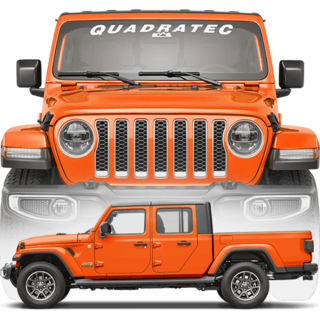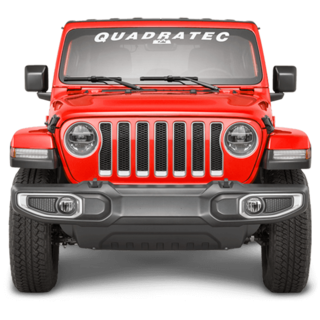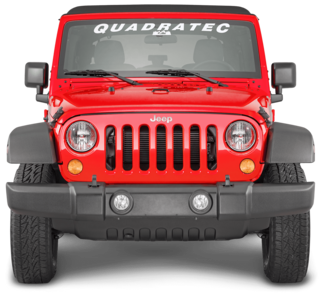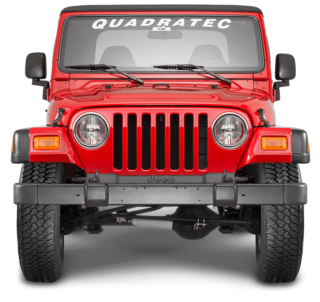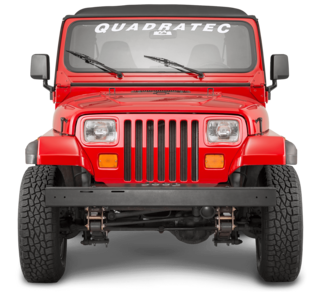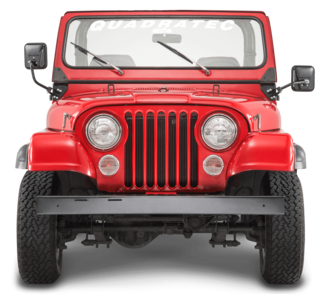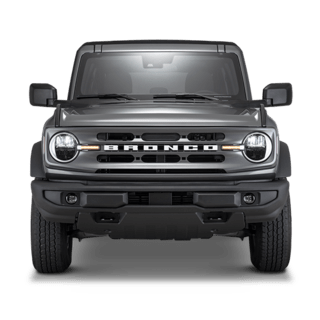« Back to product




Stewart B.
Will this fit a stock height jeep Wrangler 2012

No, Rough Country's product description states that this steering stabilizer only fits models equipped with a 2-inch or more suspension lift and does NOT fit stock-height models.
William B.
I installed the 2.5" RC lift on my 15 JK, would this be a good addition to tighten the handling up a bit.

The cause of loose steering after lifting a Jeep can have any number of causes. We'd recommend having a proper 4-wheel alignment done by a shop experienced with lifted vehicles perform an alignment and give recommendations on parts necessary to correct any adjustments that are needed. A new steering stabilizer is only one possiblity.
When you lift your 2015 Jeep JK, several things can contribute to a feeling of loose or imprecise steering. It's not usually a matter of simply "tightening" something like a bolt, but rather correcting the geometry of the steering and suspension components that are altered by the lift. Here's a breakdown of the common issues and how to address them:
1. Steering Wheel Centering:
The Problem: After a lift, your steering wheel is often no longer centered when the Jeep is driving straight. This is because the track bar, which locates the axle laterally, pulls the axle to one side as the suspension is lifted.
The Solution: You need to adjust the length of the track bar.
Stock Track Bar with a Bracket: Some budget lift kits include a track bar relocation bracket. Ensure this bracket is properly installed. If the steering wheel is still off, you might need an adjustable track bar (see below).
Adjustable Track Bar: If you have an adjustable track bar (highly recommended for lifts over 2 inches), you'll need to loosen the jam nuts and rotate the threaded body of the track bar until the axle is properly centered under the Jeep. You can measure from the outside of the tires to the fender flares on both sides to ensure they are equal. Once centered, tighten the jam nuts to the manufacturer's specified torque.
Drag Link Adjustment: Once the axle is centered with the track bar, you'll then adjust the drag link to center the steering wheel. Loosen the two pinch bolts on the drag link adjuster sleeve and rotate the sleeve until the steering wheel is straight. Then, tighten the pinch bolts to the specified torque.
2. Caster Angle:
The Problem: Lifting a Jeep changes the caster angle, which is the angle of the steering axis relative to the vertical. Insufficient positive caster can lead to "floaty" or wandering steering and a lack of return to center.
The Solution: Caster is typically corrected using:
Cam Bolts: Some lower control arms have cam bolts that allow for caster adjustment.
Adjustable Control Arms: Aftermarket adjustable control arms (especially lower front) allow you to dial in the correct caster angle.
Caster Correction Brackets: These brackets reposition the lower control arm mounts to restore proper caster.
3. Toe Alignment:
The Problem: While lifting doesn't directly change toe, the altered suspension geometry can sometimes affect it. Incorrect toe-in or toe-out can cause wandering steering and premature tire wear.
The Solution: A proper wheel alignment is crucial after lifting a Jeep. A qualified alignment shop will set the correct toe, caster (if adjustable components are installed), and camber.
4. Steering Stabilizer:
The Problem: A weak or inadequate steering stabilizer won't effectively dampen vibrations and can contribute to a loose feeling, especially with larger tires.
The Solution: Consider upgrading to a heavy-duty steering stabilizer, especially if you've installed larger tires. Some people even run dual steering stabilizer setups for more aggressive off-roading.
5. Track Bar Bushings and Ball Joints:
The Problem: While not directly caused by the lift, worn track bar bushings or ball joints can exacerbate any loose steering issues after lifting. The increased leverage from larger tires can highlight existing wear.
The Solution: Inspect these components for any play or damage and replace them if necessary.
Steps to Tighten Steering After a Lift:
Center the Axle: Adjust the track bar until the front axle is properly centered under the Jeep.
Center the Steering Wheel: Adjust the drag link so the steering wheel is straight when driving straight.
Get a Proper Wheel Alignment: Take your Jeep to a reputable alignment shop to have the toe, caster, and camber adjusted. Ensure they are familiar with lifted vehicles.
Inspect Steering Components: Check the track bar bushings, ball joints, tie rod ends, and drag link ends for any wear or play. Replace if needed.
Consider a Steering Stabilizer Upgrade: If the steering still feels loose, especially with larger tires, consider upgrading your steering stabilizer.
When you lift your 2015 Jeep JK, several things can contribute to a feeling of loose or imprecise steering. It's not usually a matter of simply "tightening" something like a bolt, but rather correcting the geometry of the steering and suspension components that are altered by the lift. Here's a breakdown of the common issues and how to address them:
1. Steering Wheel Centering:
The Problem: After a lift, your steering wheel is often no longer centered when the Jeep is driving straight. This is because the track bar, which locates the axle laterally, pulls the axle to one side as the suspension is lifted.
The Solution: You need to adjust the length of the track bar.
Stock Track Bar with a Bracket: Some budget lift kits include a track bar relocation bracket. Ensure this bracket is properly installed. If the steering wheel is still off, you might need an adjustable track bar (see below).
Adjustable Track Bar: If you have an adjustable track bar (highly recommended for lifts over 2 inches), you'll need to loosen the jam nuts and rotate the threaded body of the track bar until the axle is properly centered under the Jeep. You can measure from the outside of the tires to the fender flares on both sides to ensure they are equal. Once centered, tighten the jam nuts to the manufacturer's specified torque.
Drag Link Adjustment: Once the axle is centered with the track bar, you'll then adjust the drag link to center the steering wheel. Loosen the two pinch bolts on the drag link adjuster sleeve and rotate the sleeve until the steering wheel is straight. Then, tighten the pinch bolts to the specified torque.
2. Caster Angle:
The Problem: Lifting a Jeep changes the caster angle, which is the angle of the steering axis relative to the vertical. Insufficient positive caster can lead to "floaty" or wandering steering and a lack of return to center.
The Solution: Caster is typically corrected using:
Cam Bolts: Some lower control arms have cam bolts that allow for caster adjustment.
Adjustable Control Arms: Aftermarket adjustable control arms (especially lower front) allow you to dial in the correct caster angle.
Caster Correction Brackets: These brackets reposition the lower control arm mounts to restore proper caster.
3. Toe Alignment:
The Problem: While lifting doesn't directly change toe, the altered suspension geometry can sometimes affect it. Incorrect toe-in or toe-out can cause wandering steering and premature tire wear.
The Solution: A proper wheel alignment is crucial after lifting a Jeep. A qualified alignment shop will set the correct toe, caster (if adjustable components are installed), and camber.
4. Steering Stabilizer:
The Problem: A weak or inadequate steering stabilizer won't effectively dampen vibrations and can contribute to a loose feeling, especially with larger tires.
The Solution: Consider upgrading to a heavy-duty steering stabilizer, especially if you've installed larger tires. Some people even run dual steering stabilizer setups for more aggressive off-roading.
5. Track Bar Bushings and Ball Joints:
The Problem: While not directly caused by the lift, worn track bar bushings or ball joints can exacerbate any loose steering issues after lifting. The increased leverage from larger tires can highlight existing wear.
The Solution: Inspect these components for any play or damage and replace them if necessary.
Steps to Tighten Steering After a Lift:
Center the Axle: Adjust the track bar until the front axle is properly centered under the Jeep.
Center the Steering Wheel: Adjust the drag link so the steering wheel is straight when driving straight.
Get a Proper Wheel Alignment: Take your Jeep to a reputable alignment shop to have the toe, caster, and camber adjusted. Ensure they are familiar with lifted vehicles.
Inspect Steering Components: Check the track bar bushings, ball joints, tie rod ends, and drag link ends for any wear or play. Replace if needed.
Consider a Steering Stabilizer Upgrade: If the steering still feels loose, especially with larger tires, consider upgrading your steering stabilizer.
Randy H.
Will this fit 1.665 aftermarket hd tie rod?

No. Unfortunately this will be for a stock steering linkage only. Thanks for your inquiry.
Jesse L.
Will this fit a jeep jk rubicon with HD tie rod and a 1.5 lift?

No. Rough Country states a minimum of 2" is required for use. Thanks for your inquiry.

